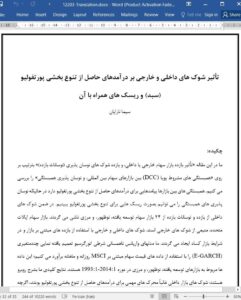Abstract
This paper evaluates the influence of foreign or domestic stock market return and return of volatility shocks on dynamic conditional correlations (DCCs) between international stock markets and correlation volatility, respectively. The correlations between markets have implications for the gains from portfolio diversification, while correlation volatilities can be seen as risks to portfolio diversification. Meanwhile, domestic shocks are sourced from the return and return volatility from 24 developed, emerging, and frontier stock markets. The US stock market is the source of foreign shocks. The domestic and foreign shocks are derived using market-based returns and under bearish market conditions. We estimate multivariate exponential generalized autoregressive conditional heteroskedasticity (E-GARCH) models using daily and monthly MSCI based stock price data of selected developed, emerging, and frontier markets over 1993:1–2014:1. Our key results are as follows. Domestic market shocks were significant drivers of gains from portfolio diversification most of the time, although the US market effects were relatively stronger. On the other hand, the US, in terms of the number of significant cases as well as the size effects of shocks, dominated as a determinant of correlation volatility (or risks to portfolio diversification). Further, under bear market conditions, adjustments in correlations and correlation volatilities are found to be mostly US-induced. Bearish shocks, rather than market return based shocks, show strong evidence of the leverage effect. Signs of persistence of shocks are mainly noticed under bearish conditions.
6. Conclusions
We measured stock market integration as dynamic conditional correlations between markets. Taking the bilateral correlations between the US and 24 developed, emerging, and frontier markets, this paper examined the impact of market shocks from domestic and US markets on correlations and their variances over the period from 2000 to 2013.
The multivariate EGARCH model was employed to examine the influences of return shocks on correlations and volatility shocks on correlation volatility. This model, while widely applied to market returns, was applied to pairwise correlations for the first time. A comparison of market returns results suggested, in most cases, that monthly correlations reacted to return and volatility shocks in a similar fashion to market returns. For instance, the US return volatility shocks rather than US return shocks were found to be popular within this framework. Similarly, the size, rather than the sign, of leverage effects was found to be important. However, there were some differences. Unlike returns volatility, the volatility of correlations with the US showed limited leverage effects. Further, persistence of correlations volatility was mainly missing in monthly models but was present in some form in daily models. This means that domestic and foreign shocks could persist for up to a month.











